
© Rosalie O’Connor. (Click image for larger version)
American Ballet Theatre
Sylvia
★★★★✰
New York, Metropolitan Opera House
11 May 2016
www.abt.org
Nymphs on the Bridge
What is it about Frederick Ashton’s Sylvia? The plot is silly and requires not one but four deus ex machina moments to reach its blissful conclusion. Most of the characters are one-note, and the group numbers in the last act are pure music-hall, all hoppity-hop and waving arms. And yet, if you’re not put off by some of the details, you gradually come to the realization that it’s an irresistible ballet. The more you see it, the more you want to see it again. This year, it is the opening ballet in American Ballet Theatre’s spring season at the Metropolitan Opera House. (This is an interesting season, with far fewer of the usual warhorses.) At just over two hours, it’s the perfect length, too.
For those who don’t know it yet: Sylvia is a ballet based on a pastoral tale by the sixteenth century poet Torquato Tasso, about a shepherd (Aminta) who falls in love with a nymph devoted to Diana, goddess of the hunt. At first the chaste Sylvia rejects his shy advances. But after being pierced by one of Eros’s arrows, she begins to develop tender feelings of her own. Unfortunately, before she realizes this she has already shot him accidentally with one of her arrows. Oops! She leaves him to die. (His agony is terrible to watch, I assure you!) Then she is kidnapped by a bad guy (Orion) dressed up like Rudolph Valentino in The Sheik, with a velvet skirt over pantaloons and silver bracelets clamped onto his forearms. He drags her to his lair and plies her with gold. Wherupon she gets him drunk and taunts him with a not-very-chaste exotic dance. Eros comes to the rescue (his third entrance) and leads her back to the revived Aminta in a magical boat, and everyone lives happily ever after. What’s not to love?
Part of the secret to Sylvia is of course Léo Delibes’s score; like the story, it has its silly moments, but when it soars, it is utterly seductive. There’s the fabulous entrance of the nymphs in Act I, with its shimmering strings and rousing horns. (Imagine the Ride of the Valkyries, but less Teutonic.) And the trumpet fanfare that opens the third act, the happiest march you’ve ever heard. And the arpeggiated strings that accompany the man’s third-act solo, the choreography for which is full of jumps that rise and fall with the music. And the teasing pizzicato interlude for Silvia, perfect for hopping on point. Délibes’s score is just stuffed with tunes, every one of which suggests a dance.
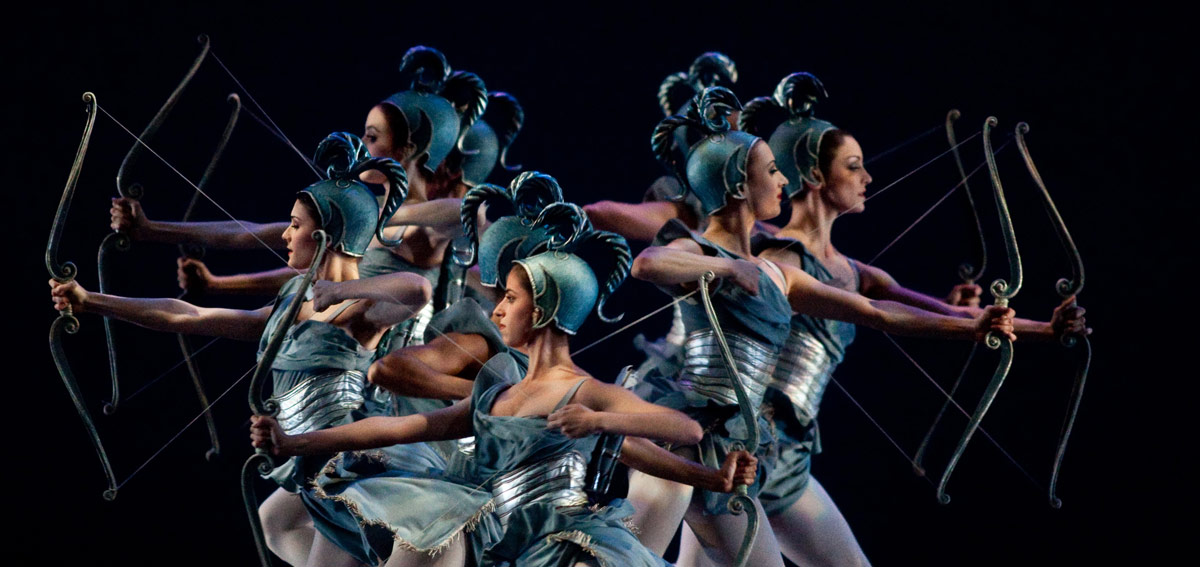
© Rosalie O’Connor. (Click image for larger version)
With his usual musical sensitivity, Ashton responds to every nuance; we feel that he is showing us exactly what the music is saying. Take Aminta’s appearance in the first act. We hear a pure, gentle melody for the flute, suggesting the pan pipes of a shepherd. But it’s so sweet, so dream-like and pure that it can only conjure a very special kind of shepherd, innocent, languid, almost feminine. And that’s Aminta. In his little tunic designed by Robin and Christopher Ironside, with one shoulder exposed, he stands in fourth position on the tips of his toes, one foot in front of the other, torso slightly twisted, like a classical statue. Then he executes these very simple low arabesque turns that melt into lilting forward bends. (Actually they’re extremely difficult, as the dancers’ wobbles sometimes reveal.) The choreography shows him from all sides, as an object of beauty. There are no tricks to hide behind.
Ironside’s sets and costumes, inspired by the style of the Second Empire, further enhance the mood of the ballet. The flats look like storybook illustrations. Sylvan fronds, heavy curtains, and classical vistas frame the stage. In act one there is a little bridge upstage where we glimpse the various characters before they enter or exit: Orion spies on Sylvia from the bridge, thinking impure thoughts, before staging his attack. Sylvia falters slightly as she leaves the injured Aminta below; she is feeling the first pangs of love. We see the present and the future all at once.
Then there are all the usual Ashtonian touches: charming dances for countryfolk carrying various implements. (I’ll admit to finding the dances for the fauns and naiads impossibly cute.) An acrobatic duet for Orion’s two exotic manservants in the second act. The tiptoeing, troll-like dance for the “wizard” who cures Aminta with his magic flower – Eros in disguise. The beautiful, and highly specific use of the arms, every turn of the wrist filled with meaning. The many beautiful things he does with simple, basic ballet steps, like the spring-like sissonne and the rocking ballotté. And, of course, the role of Sylvia herself, one of Ashton’s great heroines. I love the way he gives the couple, finally reunited, a moment of privacy before the start of the grand pas de deux. He hides them behind four lines of dancers criss-crossing the stage, like curtains fluttering in the breeze. If you look closely, you can see Sylvia simply resting her head on Aminta’s chest. That’s love.
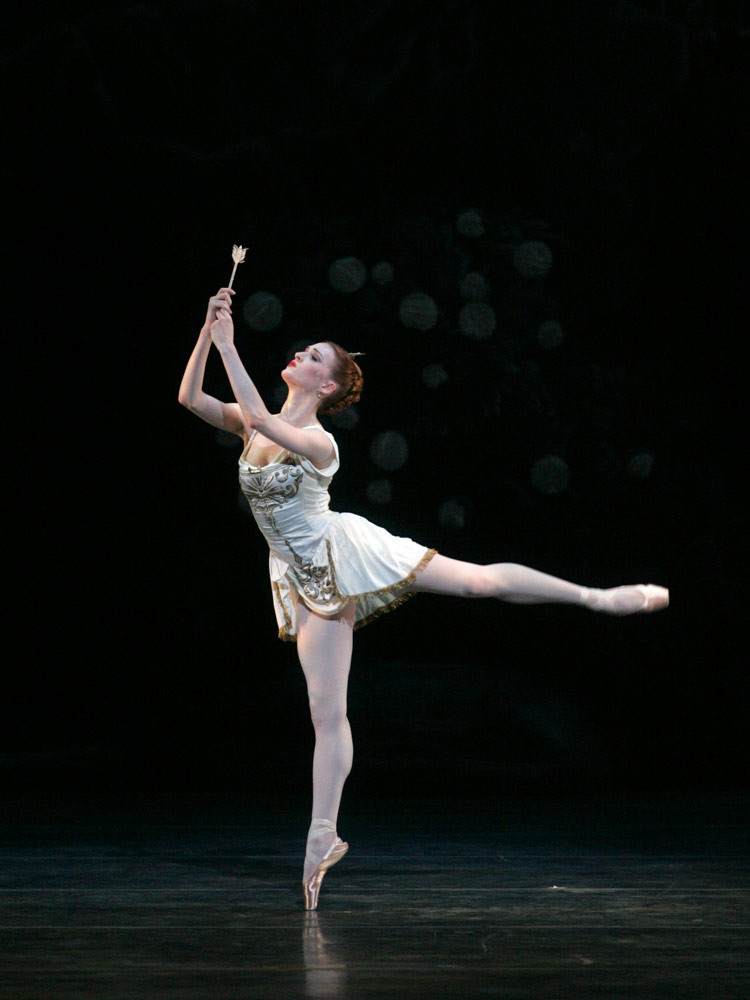
© Rosalie O’Connor. (Click image for larger version)
The role of Sylvia was created for Margot Fonteyn, then in her early thirties and at the height of her powers. It’s clear that Ashton was eager to show off her many qualities: her strength, her femininity, her sense of humor, and, in the final act, her ability to express the radiance of love in the simplest terms. Each dance adds a new facet to her character. In her first entrance she is strong and bright, all big jumps, powerful arabesques, and heroic arms thrust into the air. The solo that follows is delicate and soft, built out of floor-skimming bourrées and little hops. In the second act, she does a kind of hoochie-koochie, wearing a midriff-baring outfit with a skirt that looks like the tail of a peacock. She shakes her hips and arches her back sensuously, the better to bamboozle her captor.
In the final act, as in Sleeping Beauty, the heroine reveals her poise in a difficult solo full of hops on pointe, after which we get the payoff, a truly rapturous pas de deux. Even the entrance is spectacular: Aminta carries Sylvia onstage in an impossible lift, holding her up by one leg – his nose to her thigh – as she half-kneels on his shoulder, towering above him, back arched, arms outstretched. Once she is safely on the ground, her foot beats against her other leg in a staggered rhythm, like the beating of her heart. Later, he steadies her by placing his hands lightly on her temples, causing her to melt back into her arms as both of their arms open wide. It doesn’t get better than that.

© Rosalie O’Connor. (Click image for larger version)
ABT is fielding four casts. I’ve seen two: Gillian Murphy with Marcelo Gomes on opening night, and Isabella Boylston (a début) with the English dancer Xander Parish (a company début) at the Wednesday matinée. Both were very good. On opening night, Murphy’s characterization was radiant and secure, which is no surprise since she’s been dancing the ballet longer. Her landings are particularly impressive, so solid and strong. She uses her body in a very sculptural way, showing all the angles of the choreography. Her arms are soft and lovely. And she does a mean hoochie-koochie. She also uses the light well, allowing it to caress her oval face and illuminate her eyes. The final pas de deux, with Gomes, was like an explosion of joy. Gomes had looked slightly constrained by the choreography in the first act; he’s more comfortably dancing full out than presenting himself like a piece of moving sculpture. Partnering brings out all his best qualities: his attunement with his fellow dancers, his musicality, his sense of play. The Eros in this cast was Craig Salstein, who danced with brio and made the most of the character’s transformations. Orion was James Whiteside, who chewed the scenery (in a good way).
Boylston’s performance was less finished, but in its own way, just as lovely. She acted less with her face, relying more on her body to transmit emotion. In general, her movements were softer than Murphy’s, less classical, but more free. Her feet were particularly expressive: her fluttering bourrées and beats seemed to be connected directly to her nervous system. And her looseness has its advantages: in the first act, she did a step in which she lifted one leg impossibly high and held it there, while leaning back, on pointe. It was an astonishing balance. Xander Parish is, in many ways, an ideal Aminta: gorgeous to look at, with the delicate proportions of a Greek statue and a crystalline technique to match. But he did suffer a few wobbles in the opening solo, nerves probably. In the last act, he blossomed. His arrow-like leaps soared through the air, his cabrioles were beautiful, his arabesques pristine. Parish was trained at the Royal Ballet School and danced briefly for the Royal Ballet, but left for the Mariinsky in 2010, where he is now a second soloist. It is the Royal’s loss. Let’s hope he returns to New York soon.
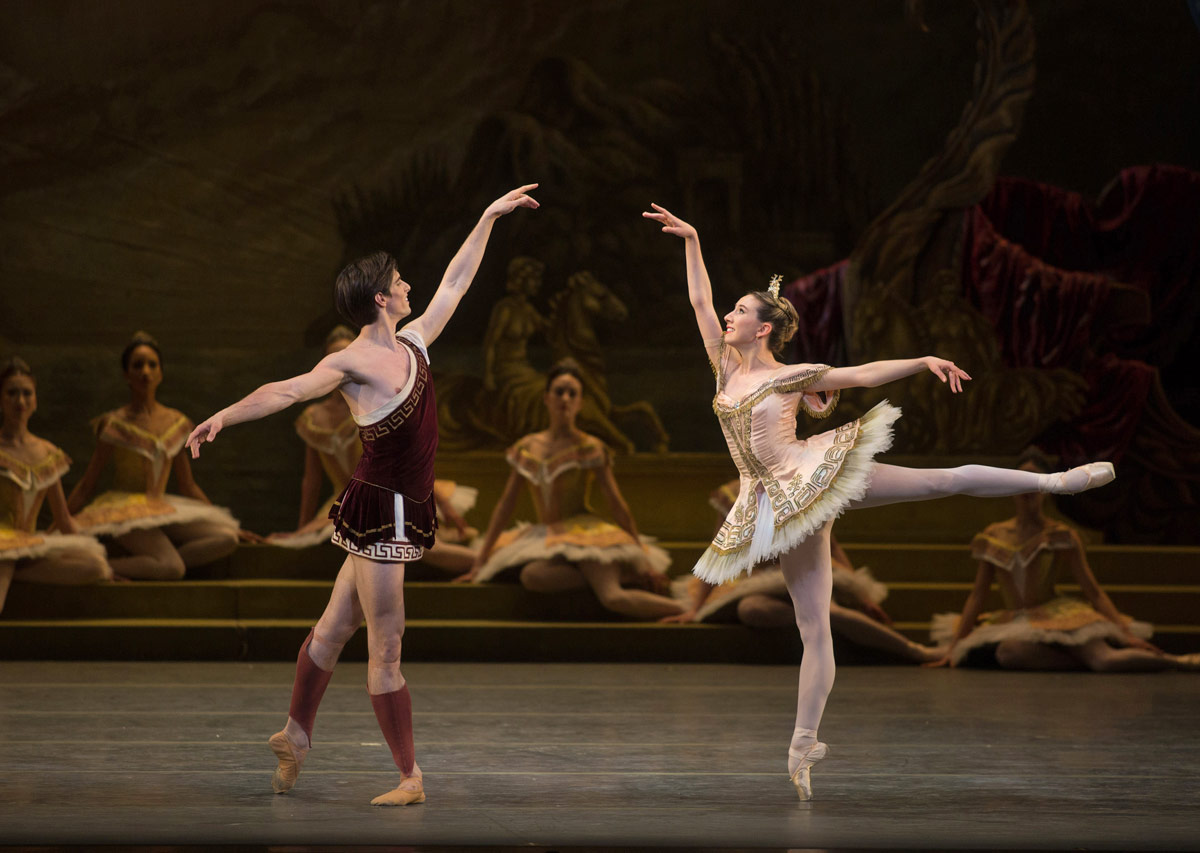
© Rosalie O’Connor. (Click image for larger version)
Aléxandre Hammoudi was a convincingly glowering Orion. The little blue goats, who dance a charming duet in the last act, were Skylar Brandt and Arron Scott. They were funny and charming without being too too cute. But the most interesting performance was Gabe Stone Shayer’s Eros: his movements had an almost eerie velvety quality that set him apart from the others – he looked as if he were not quite made of flesh and bone. After all, he is a god.
Sylvia will never please everybody. And it’s certainly not filling the Met. But once you’ve caught the bug, you’ll want to go back.












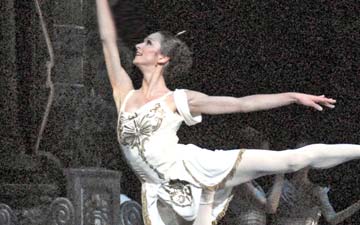
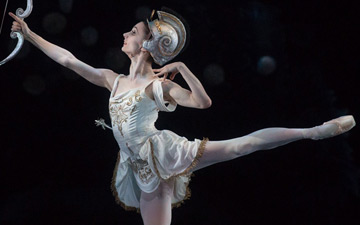

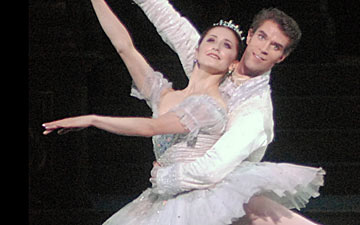

This review… aside from delivering a nice essay on what the ballet is about is about off. Gillian Murphy was clearly injured and was dancing at nowhere near full strength. Indeed, ABT announced today that she would not be dancing the evening’s performance. It would be unchilvarous to call her performance ‘bad’, but it was very clearly not a good night for her, something that leaves me wondering- which performance did you attend? Did you attend the show at all? And if so, why are you singing undue praise?
Dear Mr. George, thanks for your note. I was there on opening night, May 9th. (Though, it’s true, I’ve seen her dance the role several times.) As I said in the piece, I thought it a very good performance: nuanced, witty, sculptural, and very much in the style of the ballet. Has she ever danced the role with more vigor? Perhaps. She did slip in the second act, during her “exotic” dance, but recovered quickly. (And as you know slips are not uncommon.) But she knows the role through and through and it really suits her. At least that’s what I think! Cheers, M.